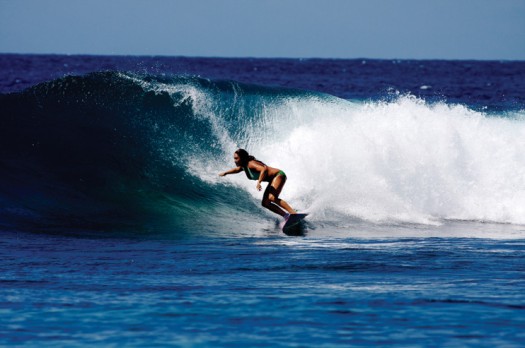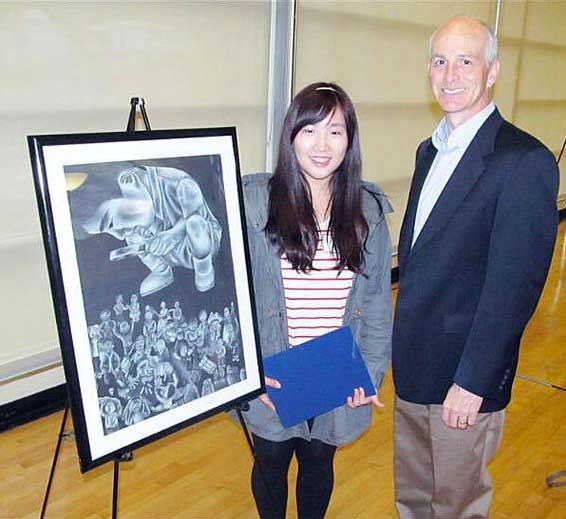Summer 2009 Issue: Girl Talk
For professional surfer and model Esther Hahn, catching a wave is more a love affair than a career.
Story by Shinyung Oh
Riding a wave beats falling in love.
So says 23-year-old surfer and model Esther Hahn.
She describes the feeling of achieving what she calls her “ultimate goal” – of barreling her lithe 5-foot, 5-inch frame in a giant wave. “You’re in the middle of a dreamland, in a different universe when you’re in there,” she says. “It’s the best feeling. It trumps all other feelings.”
In fact, “love” is a word Hahn seems to reserve for surfing, not men. “I love surfing for its positive feeling and progression,” says Hahn. As for guys they’re on the bottom of her list. If someone happens to catch her eye, this Los Angeles native prefers to keep it long distance. “Let’s plan a video chat,” she’ll suggest, her normally cool, confident demeanor tempered with a giggle and a quick tuck of her sun-kissed locks behind her ear. “It’s so much easier for me to date long distance than having to get in my car and drive to Santa Monica.”
 Her love affair with the surf began in the fourth grade when Hahn signed up for a surfing P.E. class at Carlthrop Elementary School in Santa Monica, Calif. She assumed she would just hang out on the beach while the boys surfed. But the ocean lured her in. Soon enough, she found herself the only girl paddling among a sea of boys. At 14, she won a championship contest for women’s short boarding. Other titles soon followed and Hahn joined the pros at age 17. Anastasia Ashley, a professional surfer who has competed against Hahn, describes Hahn’s surfing as a “graceful flowing style on the waves.” That signature style has landed Hahn in shores around the world, including Hawaii, Costa Rica and Indonesia.
Her love affair with the surf began in the fourth grade when Hahn signed up for a surfing P.E. class at Carlthrop Elementary School in Santa Monica, Calif. She assumed she would just hang out on the beach while the boys surfed. But the ocean lured her in. Soon enough, she found herself the only girl paddling among a sea of boys. At 14, she won a championship contest for women’s short boarding. Other titles soon followed and Hahn joined the pros at age 17. Anastasia Ashley, a professional surfer who has competed against Hahn, describes Hahn’s surfing as a “graceful flowing style on the waves.” That signature style has landed Hahn in shores around the world, including Hawaii, Costa Rica and Indonesia.
Today, Hahn is racking up sponsors like Patagonia and Power Balance. Capitalizing on her unique Asian looks in an industry still dominated by blonde, blue-eyed female surfers, Hahn has shifted her focus from competition to modeling for sports clothing and surf labels. While she’s trying to catch the perfect wave in Barbados or Bali, her photographer is always nearby, trying to catch the perfect shot. But don’t think Hahn is just going for beach babe status. She hates sitting idly on the beach. When she sees an ocean, her mind is focused on nothing other than the quality of the waves. There may be no computer or desk, but the ocean is undoubtedly Hahn’s office. “When I go to the beach,” she says, “I’m in work mode.” Every morning, Hahn wakes up at 5:30 to drive out to El Porto in Manhattan Beach, Calif. where she surfs for three hours. After, she returns home for breakfast and works out with a trainer for two hours of intense cardio and weightlifting. Then it’s back to El Porto by 4 p.m. for another three-hour surf session. She goes to bed by 9.
It’s a routine she knows well. When Hahn was a student at PolyTechnic High School in L.A., she and her mother Debbie moved into a beach house just steps from El Porto so that Hahn could have easy access to the beach, while Dad and brother Timmy stayed in their Hancock Park home. Every morning, Debbie shook her out of bed to make sure she hit the waves. Three hours later, Debbie ran out to the beach to corral Hahn in. If Hahn dawdled, Debbie grabbed the lifeguard’s binoculars and yelled at her daughter through the bullhorn.
In fact, it was Debbie who traveled with her daughter to some competition or another on three out of four weekends a month. It was a grueling schedule for a teenager, and every once in a while, one turned to the other and said, “Let’s quit.” But quitting just doesn’t seem to be in Hahn’s blood. “Debbie is high energy,” says Dan Cobley, who has been Hahn’s surfing mentor since she was 14. “Esther takes after her. Just like her mother.” There was a time, however, when Hahn considered cutting back on her surfing. After years of competition, Hahn decided to take a four-year break to study at Yale University. Not only was she feeling burnt out from struggling on the World Qualifying Series competition circuit, staying in seedy hotels and traveling almost every weekend, she also valued education. While at Yale, she tried to squeeze in some East Coast surfing and trips abroad, but she quickly cut back on water time when her grades began suffering during her first semester. This little break gave Hahn a taste of the life she never had. Always having felt a “twinge of jealousy” toward girls who didn’t travel as much as she did, who had time to focus on relationships, Hahn tried out the role of the supportive girlfriend while at Yale. She attended all of her boyfriend’s hockey games and gave up her own training when her schedule conflicted with his. She visited him in Minnesota, and met girls whose lives seemed to evolve around their boyfriends’ sports, not their own. Although she found it “fulfilling” to support her man, she also realized that she did not want to sacrifice her own ambitions for someone else.
She also tried out a more “normal” social life during her summer in New York City working at a public relations firm. There is a hint of wistfulness in her voice when she recalls that life of staying out late, going to clubs and late night dinners, and hanging out with the I-banking crowd. When people asked her what she did, she identified herself as working in P.R. instead of as a professional surfer. But soon, she realized that as much as she enjoyed the city life, her life felt empty without surfing.
It was a sacrifice she felt she could no longer make – and Hahn is no stranger to sacrifices. Ask her about the time she got dragged across a reef, ripping up her back against a stretch of coral. Or the time she banged up her head on a rock in the Maldives. Or found herself swimming for her life to escape sharks in Costa Rica. But physical injuries barely register as sacrifices in Hahn’s mind. Not when love is involved. When the topic returns to surfing, the sound of determination – as well as that word – bounces back into her voice. “I definitely love to do it because if I didn’t love it, I still wouldn’t be doing it,” she says. “I hate dabbling in things. It’s only worth my time if I’m fully going to do it.”
So when it rains and health officials warn the populace to stay out of the water for 72 hours, Hahn charges into the water, the smokestacks of Chevron Refineries looming ominously in the background. Hahn simply shrugs her shoulders and says she’s up to date on her hepatitis shots. Even a doctor’s advice to stop surfing for six months due to an injury – one in which metal plates and 28 screws once kept together the shattered pieces of her elbow – isn’t enough to keep Hahn out of the water. She’s back paddling along in less than a few months.
On this particular sunny day, an equally sunny Hahn arrives at El Porto, her long hair in a ponytail, donning yellow plastic sunglasses, a matching yellow T-shirt, green shorts with the word “Vegan” across the bottom, and Uggs. She quickly changes into her wetsuit and pulls out her 9-foot long surfboard from her white Toyota Tacoma. She paddles into the water to join the other heads bopping in the ocean.
Move over, boys. Esther Hahn is here to surf.







